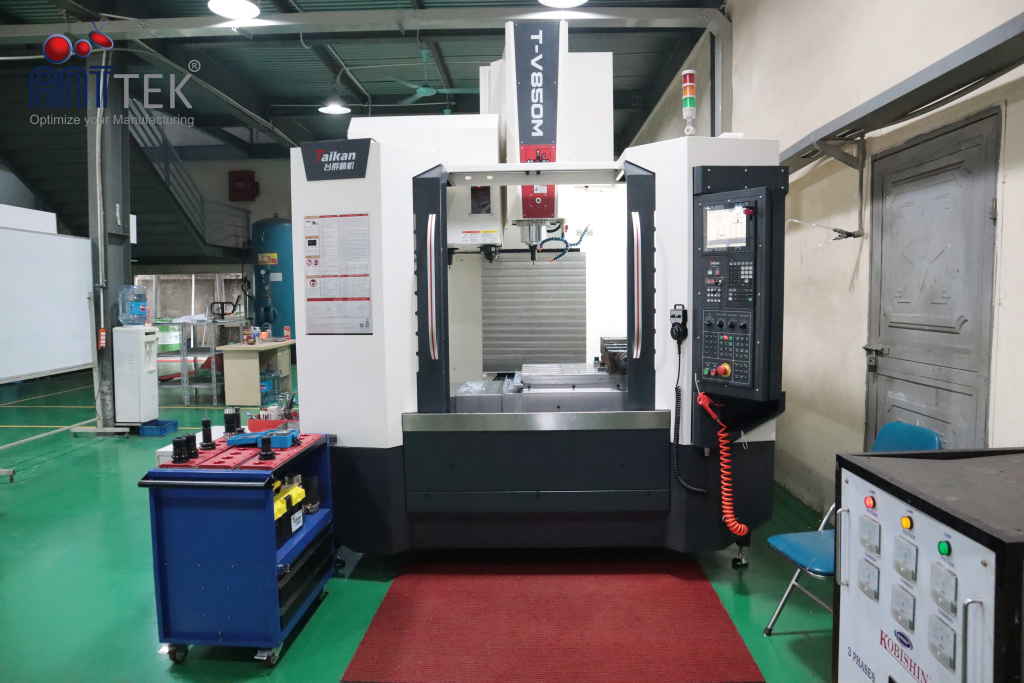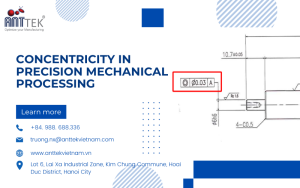What is CNC machining? Anttek Vietnam – prestigious and quality precision mechanical processing unit
In the world of modern manufacturing, precision, efficiency, and automation are paramount. One technology that embodies these qualities is CNC machining. In this article, we’ll delve into the fundamentals of CNC machining, its applications, advantages, and why it’s a cornerstone of today’s manufacturing landscape.
What is CNC machining?
CNC machining, which stands for Computer Numerical Control machining, is a precise and automated manufacturing process used to create complex parts and components from a variety of materials. It involves the use of computer-controlled machines (CNC machines) to remove material from a workpiece, following a specific design or set of instructions provided by a computer program. This process is highly efficient and allows for the production of intricate and accurate parts with tight tolerances.

How CNC Machining Works
Design
The process begins with a 3D model of the part to be manufactured, created using Computer-Aided Design (CAD) software. This digital model defines the specifications and geometry of the component.
Programming
A CNC program is generated based on the CAD model. This program contains instructions that guide the CNC machine on how to move its cutting tools, rotary devices, or other tools along multiple axes to shape the workpiece.
Setup
The workpiece is securely mounted on the CNC machine, and the appropriate cutting tools are loaded into the machine’s tool holders. The machine is calibrated for precise positioning.
Machining
The CNC machine executes the programmed instructions, controlling the movement of the cutting tools in a highly precise manner. Material is gradually removed, creating the final shape of the part.
Quality Control
During and after the machining process, measures are taken to ensure the part meets the required specifications. This may involve measurements, inspections, and testing.

The different types of CNC machining
CNC machining encompasses a wide range of techniques and processes, each tailored to specific applications and material requirements. Here are some of the different types of CNC machining, each with its unique characteristics and applications:
Milling
- Vertical Milling: A spindle with a vertical orientation is used to remove material from the workpiece. Suitable for creating flat surfaces, pockets, and slots.
- Horizontal Milling: The spindle is horizontally oriented, allowing for more extensive material removal and improved chip evacuation. Ideal for larger workpieces and production runs.
- 3-Axis, 4-Axis, and 5-Axis Milling: Refers to the number of axes along which the milling machine can move. 3-axis machines move in X, Y, and Z directions, while 4-axis and 5-axis machines add rotational movement. These multi-axis machines can produce complex, contoured shapes.
Turning
- CNC Lathe: Used for cylindrical parts, a CNC lathe rotates the workpiece while a single-point cutting tool shapes it. Can create intricate details, such as threads and taper.
- Swiss-Type CNC Lathe: Designed for high-precision and small-diameter workpieces. Allows simultaneous machining from multiple angles.
Drilling
CNC Drilling: Automated drilling machines create holes in various materials with precise positioning and depth control
Grinding
CNC Grinding: Utilizes abrasive wheels to achieve high levels of precision and surface finish. Used for applications requiring tight tolerances and smooth surfaces, such as in the production of precision tools, medical devices, and aerospace components.
EDM (Electrical Discharge Machining)
- Wire EDM: Uses a thin, electrically charged wire to cut intricate shapes in conductive materials with very high precision.
- Sinker EDM: Creates cavities and shapes in the workpiece using a shaped electrode that discharges electrical sparks.
Plasma Cutting
CNC Plasma Cutting: Utilizes a focused jet of high-temperature plasma to cut through electrically conductive materials, commonly used in metal fabrication.
Waterjet Cutting
CNC Waterjet Cutting: Uses a high-pressure stream of water mixed with abrasive material to cut through a wide range of materials, including metal, plastic, and stone.
Laser Cutting
CNC Laser Cutting: Utilizes a focused laser beam to cut through various materials with high precision. Used in industries like sheet metal fabrication, electronics, and signage.
Routing
CNC Router: Used for cutting and shaping materials, particularly in woodworking, plastics, and composites. Can create intricate designs and cutouts.
Additive Manufacturing (3D Printing)
CNC 3D Printing: While not traditional subtractive CNC machining, it’s worth mentioning as a type of CNC due to its computer-controlled nature. It builds up layers of material to create 3D objects.

Choose Anttek as your CNC machining unit
Anttek Vietnam – Proud to be the leading precision engineering specialist in domestic and foreign markets. Anttek is honored to connect and cooperate with customers. Contact us now for HIGH-QUALITY PRODUCTS – COST OPTIMIZATION – GUARANTEE PROGRESS OF DELIVERY.
For details, please contact:
- Headquarters: Lot G07, Kien Hung Land QSD Auction, Kien Hung Ward, Ha Dong District, Hanoi City, Viet Nam
- Factory: Lô 6, khu CN Lai Xá, Kim Chung, Hoài Đức, Hà Nội
- Hotline: (+84) 988 688 336 / (+84) 385 552 628
- Email: truong.nx@anttekvietnam.com
- Website: https://anttekvietnam.com
CNC machining has transformed manufacturing by offering a combination of precision, automation, and versatility. Its ability to produce high-quality parts with consistent accuracy makes it a cornerstone of modern industrial processes. As technology continues to advance, CNC machining will undoubtedly play a central role in shaping the future of manufacturing.

















